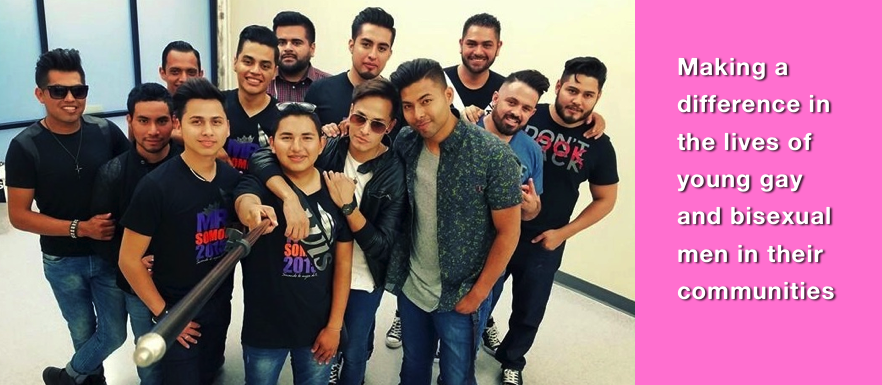The Project’s Guiding Principles and Core Elements are described in detail throughout the Mpowerment Project (MP) manual, and you’ll also see examples of successful adaptations in each module. Following the Guiding Principles in adapting the intervention is essential, because they provide guidance in how to modify the program in ways that retain the essence of the program. The MP manual is free at mpowerment.org
 |
| These adaptation modules are free at mpowerment.org |
The Mpowerment
Project was designed
from the very
beginning to be
tailored to the unique needs of each community.
Those CBOs who have experienced the most success with the Mpowerment Project facilitated an empowering, community-building process among young men in their community. They gave real decision-making authority to the young men in Core Group and found dedicated, skilled, and charismatic community members to work as paid staff, that is, as Project Coordinators.
 |
| The GMHC Crew | Mpowerment Fairfax VA |
RELATED: 7 African American & Men of Color Mpowerment Projects
The most successful Projects were both gay-affirming and sex-positive, and they sponsored a wide range of fun and engaging Social Outreach activities that attracted men to the Project, particularly men who had not been interested in attending HIV/AIDS prevention activities or organizations. The Projects successfully linked HIV prevention to the fulfillment of the young men’s social needs. The most successful Projects also mobilized young men to support their friends to have safer sex and knowing one's HIV status by teaching them in regularly scheduled peer-led groups about how to have supportive conversations regarding HIV prevention.
RELATED: The Mpowerment Project has been enhanced to help young MSM (YMSM) living with HIV to engage in the HIV treatment cascade.
 |
| THE RETREAT. The Mu Crew, Mpowerment Dayton OH |
After attending these small groups and Social Outreach Events, the young men felt motivated and empowered to support each other about HIV testing and safer sex, both with friends they had already had, as well as with new friends. Men also heard more messages from each other about the importance of having safer sex and regular HIV testing. We observed and heard, again and again, that the CBOs that implemented the Mpowerment Project with fidelity had the most success reaching out to young men in the community and recruiting them to show up at events.
When we talk about “fidelity” we do not mean strict adherence to the exact ways that the intervention was conducted in our research. The MP was designed from the very beginning to be tailored to the unique needs of each community. The types of events that are most successful in Texas or Vancouver BC might never go over well with young men in California (or vice versa). We were heartened to see that many programs successfully modified the intervention so it was more relevant to their population or setting and fit the unique needs of their community, while still following the philosophy or spirit of the MP that is spelled out in the Guiding Principles. Researchers call these kind of changes to a program 'faithful' adaptation.
 |
| The Q Austin, Mpowerment TX |
RELATED: 5 important questions for the Mpowerment Project to ask itself.
Case Study - Mpowerment Detroit, MI.
Mpowerment Detroit, a very successful Mpowerment Project prioritizing African American men who have sex with men (MSM) adapted the Core Group guidelines by creating six-month internships for young men interested in joining. They felt that the Project would be more successfully implemented if more structure was provided to the Core Group. The internship concept was their way of achieving a very committed group by adding status and responsibility to the position of Core Group members.
Each intern was assigned a mentor from the already established Core Group. The interns were then given a checklist of required activities to conduct before “graduating” to full core group status. While an internship process may seem like a major deviation from the original Core Group design, which was open to all, in fact the changes were grounded in the Guiding Principles (for more information about the Guiding Principles of the Mpowerment Project, download Module 1: Overview). Here is how:
- The Empowerment Guiding Principle was adhered to because the Core Group members themselves decided on this change and continued to run the Core Group themselves, and even the interns had a strong voice in the group’s decision-making process.
- The Social Focus Guiding Principle was adhered to because the group worked hard to create an atmosphere of togetherness and family. They even chose to adopt the name, “Young Brothers United,” and they worked hard to make their meetings fun as well as productive.
- The power of Peer Influence Guiding Principle was adhered to since established Core Group members worked as mentors to interns, while continuing to spread the message about HIV prevention to their friends.
- And, in a major indicator of the Project’s success, the Community- Building Guiding Principle was adhered to as numerous, carefully designed events were planned and executed, complete with safer sex messaging throughout.
 |
| Mpowerment Detroit, MI |
These Projects then hired younger men into the remaining Coordinator positions. By doing so, they still recognized the importance of Peer Influence, while also acknowledging that communities only develop into strong and healthy ones if they have talented and experienced leaders. So, when these Projects hired a Team Leader outside the recommended age range of the Project, they were also helping to ensure its future success by making a concerted effort to help the younger Coordinators develop into future community leaders.
RELATED: What characteristics make for a successful coordinator?
The Mpowerment Project is one of the Centers for Disease Control (CDC) effective interventions.
The UCSF Capacity Building Assistance Partnership. Making high-impact HIV prevention possible with
UCSF Center for AIDS Prevention Studies and
UCSF Alliance Health Project. 
